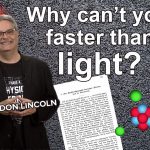Einstein’s theory of special relativity is one of the most counterintuitive ideas in physics, for instance, moving clocks record time differently than stationary ones. Central to all of the equations of relativity is the Lorentz factor, also known as gamma. In this video, Fermilab’s Dr. Don Lincoln not only shows you a simple way to derive gamma, he also tells you its physical significance.
Even as Fermilab produces world-class research, it is closely tied to the local community, drawing students and teachers through its public engagement programs. Some of the lab’s younger guests are impressive, as illustrated by an encounter that scientist Sowjanya Gollapinni shared with a visiting middle school neighbor.
One of the most counterintuitive facts of our universe is that you can’t go faster than the speed of light. From this single observation arise all of the mind-bending behaviors of special relativity. But why is this so? In this in-depth video, Fermilab’s Dr. Don Lincoln explains the real reason that you can’t go faster than the speed of light.


